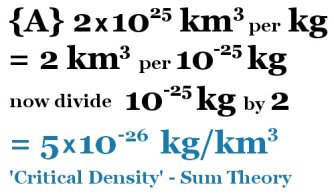| Time for 2 bodies to attract under gravity There
is something of a disagreement on various websites as to what is
the correct formula for calculating the time it takes for two bodies
to attract under gravity. The formula following is in perfect agreement
with the OGS12 algorithm (orbit-gravity-sim-12.exe): |
||
|
Most websites offer this incorrect formula: . |
||
|
So how do we decide what is the correct formula? Well the OGS12
algorithm uses the most ordinary equations for gravity (g=m/r^2)
then simply allows time to compute in a purely evolutionary manner
– and this program gives excellent results to within a matter
of millimetres for the orbits of the Moon, the Earth and other planets
– even when not running at its most precise rate of computation.
So if we consider the data from the previous section, and place it into the correct exact formula so that we can establish: {A}
How long it will take for gravity to attract a pair of 1kg objects
if they are: {B}
How long it will take for gravity to attract a pair of 1kg objects
if they are: Now
for {A} the mass-per-volume is 1kg per 2x10^16
km^3, So
if we invert those amounts we see that the volume-per-mass is
then: Be
careful of the detail in those last two conversions. When we are
converting the amounts from mass-per-volume to volume-per-mass
we should do this one step at a time like this: |
||
|
So because we have determined the Universe is 13.7 billion years
old, the critical density can only be 5x10^-17
kg/km^3 {A}, whereas {B} yields a density that will
coalesce in a much longer time than the age of the Universe.
Another
amusing example we can use is two 75g objects 10cm apart. They
would take about 3 hours to attract together due to gravity. Now
the Beautiful Attraction Principle (see previous section) shows
us that if two objects, one of 100kg, another of 50kg, are 1 meter
apart, then under gravitational attraction it would also take
about 3 hours for them to make contact. This is the same for two
75kg objects 1 meter apart. Or, an object at 85kg and another
at 65kg at 1 meter would yield an identical result. |
||
| This is an extract summary of Chapter XXX of the book: Flight Light and Spin Download page for relativity simulation: algorithm orbit-gravity-sim-12.exe The full chapter can be downloaded here: Sum-Theory.pdf (5.5 mb, 57 pages, this pdf file is too big for chrome, use firefox) List of: abbreviated short articles . . |
|||||






